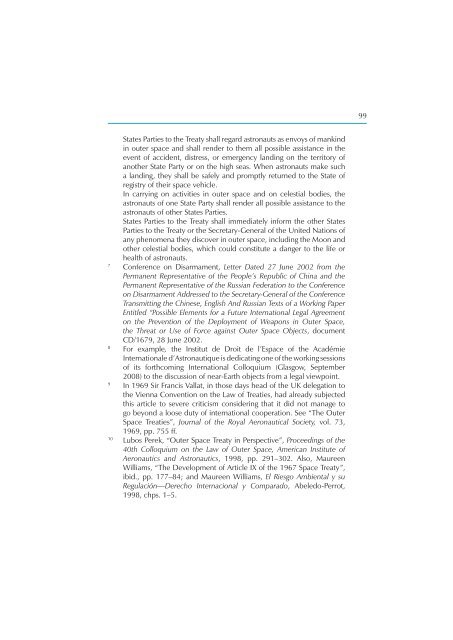Security in Space The Next Generation - UNIDIR
Security in Space The Next Generation - UNIDIR
Security in Space The Next Generation - UNIDIR
You also want an ePaper? Increase the reach of your titles
YUMPU automatically turns print PDFs into web optimized ePapers that Google loves.
States Parties to the Treaty shall regard astronauts as envoys of mank<strong>in</strong>d<br />
<strong>in</strong> outer space and shall render to them all possible assistance <strong>in</strong> the<br />
event of accident, distress, or emergency land<strong>in</strong>g on the territory of<br />
another State Party or on the high seas. When astronauts make such<br />
a land<strong>in</strong>g, they shall be safely and promptly returned to the State of<br />
registry of their space vehicle.<br />
In carry<strong>in</strong>g on activities <strong>in</strong> outer space and on celestial bodies, the<br />
astronauts of one State Party shall render all possible assistance to the<br />
astronauts of other States Parties.<br />
States Parties to the Treaty shall immediately <strong>in</strong>form the other States<br />
Parties to the Treaty or the Secretary-General of the United Nations of<br />
any phenomena they discover <strong>in</strong> outer space, <strong>in</strong>clud<strong>in</strong>g the Moon and<br />
other celestial bodies, which could constitute a danger to the life or<br />
health of astronauts.<br />
7 Conference on Disarmament, Letter Dated 27 June 2002 from the<br />
Permanent Representative of the People’s Republic of Ch<strong>in</strong>a and the<br />
Permanent Representative of the Russian Federation to the Conference<br />
on Disarmament Addressed to the Secretary-General of the Conference<br />
Transmitt<strong>in</strong>g the Ch<strong>in</strong>ese, English And Russian Texts of a Work<strong>in</strong>g Paper<br />
Entitled “Possible Elements for a Future International Legal Agreement<br />
on the Prevention of the Deployment of Weapons <strong>in</strong> Outer <strong>Space</strong>,<br />
the Threat or Use of Force aga<strong>in</strong>st Outer <strong>Space</strong> Objects, document<br />
CD/1679, 28 June 2002.<br />
8 For example, the Institut de Droit de l’Espace of the Académie<br />
Internationale d’Astronautique is dedicat<strong>in</strong>g one of the work<strong>in</strong>g sessions<br />
of its forthcom<strong>in</strong>g International Colloquium (Glasgow, September<br />
2008) to the discussion of near-Earth objects from a legal viewpo<strong>in</strong>t.<br />
9 In 1969 Sir Francis Vallat, <strong>in</strong> those days head of the UK delegation to<br />
the Vienna Convention on the Law of Treaties, had already subjected<br />
this article to severe criticism consider<strong>in</strong>g that it did not manage to<br />
go beyond a loose duty of <strong>in</strong>ternational cooperation. See “<strong>The</strong> Outer<br />
<strong>Space</strong> Treaties”, Journal of the Royal Aeronautical Society, vol. 73,<br />
1969, pp. 755 ff.<br />
10 Lubos Perek, “Outer <strong>Space</strong> Treaty <strong>in</strong> Perspective”, Proceed<strong>in</strong>gs of the<br />
40th Colloquium on the Law of Outer <strong>Space</strong>, American Institute of<br />
Aeronautics and Astronautics, 1998, pp. 291–302. Also, Maureen<br />
Williams, “<strong>The</strong> Development of Article IX of the 1967 <strong>Space</strong> Treaty”,<br />
ibid., pp. 177–84; and Maureen Williams, El Riesgo Ambiental y su<br />
Regulación—Derecho Internacional y Comparado, Abeledo-Perrot,<br />
1998, chps. 1–5.<br />
99








